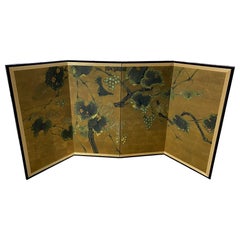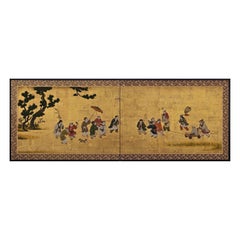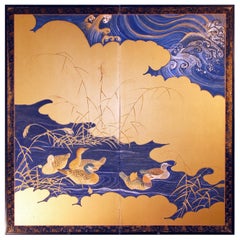Paintings and Screens
21st Century and Contemporary Chinese Paintings and Screens
Gold Leaf
20th Century Japanese Showa Paintings and Screens
Gold Leaf
17th Century Edo Antique Paintings and Screens
Gold Leaf
Early 18th Century Japanese Edo Antique Paintings and Screens
Gold Leaf
Early 19th Century Japanese Edo Antique Paintings and Screens
Gold Leaf
20th Century Japanese Showa Paintings and Screens
Gold
Early 19th Century Japanese Edo Antique Paintings and Screens
Gold Leaf
Early 19th Century Japanese Edo Antique Paintings and Screens
Gold Leaf
18th Century Japanese Edo Antique Paintings and Screens
Gold Leaf
Early 19th Century Japanese Edo Antique Paintings and Screens
Gold Leaf
Mid-19th Century Japanese Edo Antique Paintings and Screens
Gold Leaf
Late 18th Century Japanese Edo Antique Paintings and Screens
Gold Leaf
20th Century Japanese Showa Paintings and Screens
Gold Leaf
Late 18th Century Japanese Edo Antique Paintings and Screens
Gold Leaf
Mid-20th Century Japanese Showa Paintings and Screens
Gold Leaf
Early 20th Century Japanese Taisho Paintings and Screens
Gold
20th Century Japanese Edo Paintings and Screens
Bronze
Mid-18th Century Japanese Antique Paintings and Screens
Gold Leaf
2010s Nepalese Paintings and Screens
Gold Leaf
21st Century and Contemporary Japanese Meiji Paintings and Screens
Gold
20th Century Paintings and Screens
Gold Leaf
18th Century Japanese Antique Paintings and Screens
Gold, Bronze, Gold Leaf
2010s Nepalese Paintings and Screens
Gold Leaf
18th Century Japanese Edo Antique Paintings and Screens
Gold Leaf
Early 19th Century Japanese Antique Paintings and Screens
Gold Leaf
21st Century and Contemporary Japanese Meiji Paintings and Screens
Gold Leaf
20th Century Chinese Chinese Export Paintings and Screens
Brass, Gold Leaf
Early 20th Century Japanese Paintings and Screens
Brocade, Silk
18th Century Japanese Edo Antique Paintings and Screens
Gold Leaf
Early 20th Century Japanese Showa Paintings and Screens
Gold Leaf
Late 17th Century Japanese Antique Paintings and Screens
Gold Leaf
18th Century Japanese Edo Antique Paintings and Screens
Gold Leaf
Late 19th Century Japanese Antique Paintings and Screens
Gold
Late 19th Century Japanese Antique Paintings and Screens
Gold
Mid-20th Century Japanese Paintings and Screens
Bronze
Mid-19th Century Japanese Antique Paintings and Screens
Gold
20th Century Japanese Showa Paintings and Screens
Brass
21st Century and Contemporary Japanese Meiji Paintings and Screens
Gold
1670s Japanese Edo Antique Paintings and Screens
Gold Leaf
Early 20th Century Japanese Taisho Paintings and Screens
Bronze
Late 19th Century Japanese Antique Paintings and Screens
Gold Leaf
Early 20th Century Japanese Paintings and Screens
Gold
Early 20th Century Japanese Paintings and Screens
Gold
Mid-20th Century Japanese Paintings and Screens
Gold Leaf, Silver Leaf
1880s Japanese Antique Paintings and Screens
Gold Leaf
1930s Japanese Vintage Paintings and Screens
Bronze
Early 19th Century Japanese Meiji Antique Paintings and Screens
Gold Leaf
1930s Japanese Vintage Paintings and Screens
Bronze
19th Century Japanese Meiji Antique Paintings and Screens
Bronze, Copper
1880s Japanese Antique Paintings and Screens
Gold Leaf
Early 19th Century Japanese Edo Antique Paintings and Screens
Gold Leaf
18th Century Japanese Antique Paintings and Screens
Gold
18th Century Japanese Antique Paintings and Screens
Gold Leaf
Late 19th Century Japanese Antique Paintings and Screens
Gold
19th Century Japanese Antique Paintings and Screens
Gold
Early 19th Century Japanese Antique Paintings and Screens
Gold Leaf
21st Century and Contemporary Italian Modern Paintings and Screens
Crystal, Brass, Iron
Mid-19th Century Japanese Antique Paintings and Screens
Gold
Antique Asian Paintings and Screens
Traditional Asian paintings were often created on scrolls and folding screens. Artisans made screens that could be folded up or spread out by connecting several panels using hinges. Today, antique Asian folding screens and paintings are sophisticated decorative accents that can serve as makeshift partitions to ensure privacy.
The original folding screens were created by Chinese artists. The earliest record of screens comes from the 2nd century B.C., and surviving examples date back to the Ming dynasty. Chinese painting utilizes many of the same tools as calligraphy — these screens were crafted from wood with painted panels featuring striking art or calligraphy that told cultural stories or represented nature and life in the area.
The practice was introduced to Japan, where paintings for screens were made on paper and silk, in the 8th century. These paintings frequently feature subjects such as landscapes, animals, flowers and Buddhist religious themes. Along with screens for tea ceremonies and dance backgrounds, there were screens for use in Shinto and Buddhist temples.
In the 17th century, screens began to be imported to Europe where their popularity grew. Coco Chanel famously collected Coromandel folding screens.
Traditional Asian paintings can make a tasteful addition to any wall, and screens can be used as decoration or, in the case of larger iterations, as an aesthetic way to divide a large room. Browse the selection of antique Asian paintings and screens from a variety of styles and eras on 1stDibs.





